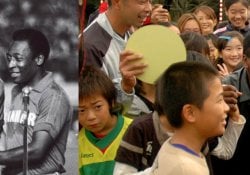In this article, we are going to talk a little about a tourist spot that takes you to the ancient period in a Samurai Village of Japan located in the Fukui region. These are the historic ruins of the Asakura clan. Hope you like this little article.
The place in Japanese is called Ichijōdani Asakura City Ruins [一乗谷朝倉氏遺跡] and is in Kidonouchi in Fukui City in the Hokuriku region of Japan. This area was controlled by the Asakura clan for 103 years during the Sengoku period.
This historic ruins and samurai village was designated a Historic Site in 1971, and in June 2007, 2,343 artifacts found were designated as Important Cultural Heritage.
Ichijōdani is a valley near the Asuwa River with a width of approximately 500 meters and a length of approximately three kilometers. The valley is surrounded by mountains to the east, west and south, and the river to the north, forming a natural fortification.
See below a video of my friend from the Otaku channel in Japan visiting this Samurais village in the Fukui region that goes unnoticed by many tourists visiting Japan. Maybe that could be your next goal.
The History of the Asakura Clan and the Ichijodani
In 1471, Asakura replaced the Shiba clan as the shugo military commander of Echizen Province. In the same year, Asakura Toshikage (1428-1481) fortified the Ichijōdani by building hilltop fortifications in the surrounding mountains and building walls and gates to seal off the northern and southern ends of the valley.
Within this area he made a fortified mansion, surrounded by the homes of his relatives and retainers, and eventually by the residences of merchants and artisans and Buddhist temples. It offered refuge to people of Kyoto culture or ability trying to escape the conflict of the Ōnin War, it became an important cultural, military and population center.
At the time of Asakura Takakage (1493-1548), the. valley had a population of over 10,000. Yoshikage succeeded his father as head of the Asakura clan and lord of the castle at Ichijōdani Castle in 1548.
The Asakura maintained good relations with the shogunate Ashikaga and thus ended up coming into conflict with Oda Nobunaga. After Nobunaga's capture of Kyoto, Shōgun Ashikaga Yoshiaki appointed Asakura Yoshikage as regent and requested help in driving Nobunaga out of the capital.

As a result, Nobunaga launched an invasion of Echizen Province. Due to the Yoshikage's lack of military skill, Nobunaga's forces were successful in the siege of Kanegasaki and the subsequent Battle of Anegawa in 1570, leaving the entire Asakura domain open to invasion.
Ichijodani was razed to the ground by Nobunaga during the siege of Ichijodani castle in 1573. Excavation of the ruins began in 1967 and continued into 2017, revealing the shape of the entire city, including the lord's house, samurai residences, temples, merchant houses. , artisans' houses and streets.
Samurai residences and merchants' quarters have been restored along the 200-meter-long street. Four Japanese gardens have been unearthed and partially restored.
Approximately 1,700,000 relics have been found in the ruins, and of these 2,343 are nationally designated Important Cultural Properties, many of which are on display at the Ichijodani Asakura Family Site Museum.





